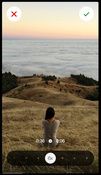
urbansheep@gmail.com
Hyperlapse, Instagram’s New App, Is Like a $15,000 Video Setup in Your Hand | Design | WIRED - http://www.wired.com/2014...

|

|
26 августа 2014 в 17:23 с Bookmarklet
кружевной патруль
Dmitry Khrustalev
осталось 9 дней мучений
Ivan Bessarabov
типа смартовый пацан
lieu
9000
“Today at 10am PST, Instagram is lifting the veil on Hyperlapse, one of the company’s first apps outside of Instagram itself. Using clever algorithm processing, the app makes it easy to use your phone to create tracking shots and fast, time-lapse videos that look as if they’re shot by Scorsese or Michael Mann. What was once only possible with a Steadicam or a $15,000 tracking rig is now possible on your iPhone, for free. (Instagram hopes to develop an Android version soon, but that will require changes to the camera and gyroscope APIs on Android phones.)” - × × ×
И тут мы такие — э-э-э... Майкрософт Ресёрч же... мнэээ... прототип же был с тем же названием же... про сшивание же на лету, сложный пост-процессинг же... а тут продакшн-на-смартфончеги, это как жешь... - × × ×
Из комментов: “As acme64 mentioned, they use two different methods to achieve the same thing. While Instagram's is based on using phone sensor data (i.e. the gyroscope) to measure phone movement, the MSR paper uses only the camera. Their dataset was gathered from first-person video (e.g. from a go pro) and uses stereo reconstruction/structure-from-motion methods to map the video into a 6-dimensional space in which they can optimize a smooth camera path. ¶
This is all pretty heavy algorithmically, and likely can't be done on a smartphone at this time, so while they have the same name (and my impression is that the name "hyperlapse" is common parlance for this problem, c.f. http://hyperlapse.tllabs.io/, which has been adopted by Instagram for their app), they solve a similar problem in very different situations, and the solutions have very different characteristics.” - × × ×
^ ^^ Ого. - осталось 9 дней мучений
© 2015 FriendFeed (and Clio archiver)